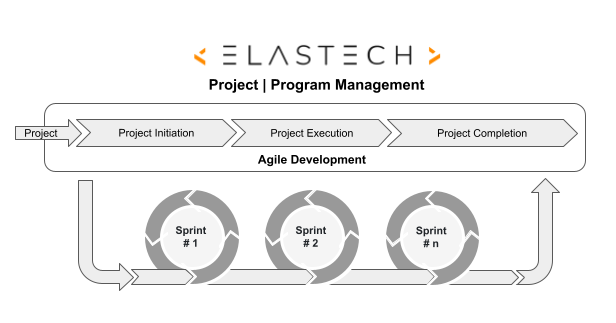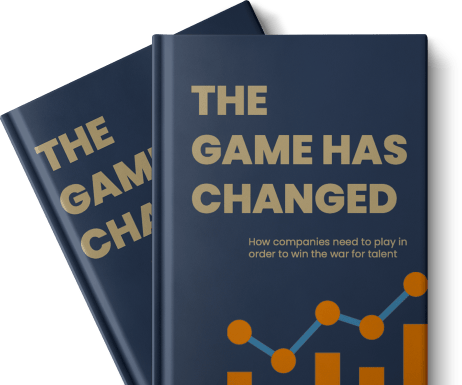Why Work With ELASTECH
Our delivery methodology
Business and technology leaders are experiencing heightened market pressures for innovation and rapid delivery of new technology solutions. Continued pressures on the bottom line are causing leaders to push for outcomes faster. The confluence of these factors is causing many businesses & IT leaders to engage with outside consulting firms to cut through internal bureaucracy and procedure as a way to deliver impactful solutions faster.
ELASTECH works with your business sponsors as well as the IT teams to ensure continuous feedback, prioritization, and delivery of the working products. This is a key to the success of your project.
Agile offers an opportunity to quickly define and validate our users’ requirements, engage our entire solution team to develop the highest priority features first, and achieve the targeted project milestone dates with the requisite – but no superfluous – functionality.
Put another way, it means that we can deliver products that are better attuned to our customers’ continually evolving needs — and we can deliver them faster.
A critical foundation of Agile development is the quality control structure that’s naturally built into the process. Unlike traditional waterfall development (which is tied to a strict, linear, stage-by-stage approach), Agile stresses the quality of the product through continuous feedback loops and iterations.
So we identify and document acceptance criteria for each feature, and then build automated tests into the software to ensure that those acceptance criteria are met prior to features being manually tested.
The result is a significant drop in imperfections in delivered software — and the ability to rapidly change functionality without jeopardizing existing capabilities.
So our clients get uninterrupted access to the features they rely on most, all while being able to take advantage of a continuous stream of product improvements.

Summary of agile development objectives
- Define and validate user requirements quickly
- Develop features in a sequence of highest priority
- Set and achieve project milestones to reach full system functionality
- Build quality control into the process
- Provide continuous feedback opportunities
- Document acceptance criteria for each feature
- Build automated tests into software
- Reduce defects in software developed
What is Agile Methodology – Explained
The Agile methodology focuses on moving quickly, releasing products often, and adapting to changes. Agile methodology has become quite popular in the last few years because of its effectiveness and outcome-driven approach.
Agile is a project management philosophy that focuses on software development. Its success relies on feedback and incremental changes which are driven by project objectives and desired outcomes.
Lastly, we have to ask the question: What is the manager/leader’s role (e.g. not the PM) in Agile development? Managers /leaders have the responsibility of ensuring:
1. Determine both the hard and soft skills that align with the project objectives.
2. Calibrate and compile the team based on those skills.
3. provide the team with a great environment so they can succeed in their work.
Collectively, these components have proven to be an effective success formula for delivering projects on time and on budget. The best part is that this same formula delivers meaningful outcomes to the business.

The Agile Mindset
ELASTECH promotes and runs its delivery operations based on the Agile Manifesto which puts forth 12 principles of Agile software development. These principles are:
1. Our highest priority is to satisfy the customer through early and continuous delivery of valuable software.
2. We welcome changing requirements, even late in development. Agile processes harness change for the customer’s competitive advantage.
3. Deliver working software frequently, from a couple of weeks to a couple of months, with a preference for the shorter timescale.
4. Business people and developers must work together daily throughout the project.
5. Build projects around motivated individuals. Give them the environment and support they need, and trust them to get the job done.
6. The most efficient and effective method of conveying information to and within a development team is face-to-face conversation. And don’t be lazy about communication by hiding behind Slack.
7. Working software is the primary measure of progress.
8. Agile processes promote sustainable development. The sponsors, developers, and users should be able to maintain a constant pace indefinitely.
9. Continuous attention to technical excellence and good design enhances agility.
10. Simplicity – the art of maximizing the amount of work not done – is essential.
11. The best architectures, requirements, and designs emerge from self-organizing teams.
12. At regular intervals, the team reflects on how to become more effective, then tunes and adjusts its behavior accordingly.
The primary principles of Agile development focus on user satisfaction the most. From releasing a working product frequently to having a good design, all of the fundamental values of this approach are focused on making users happy.
Users only care about one thing… their success. They do not care about your future strategies or how fast your company is growing. They care about how soon they get the product, how fast they get the bug fixes, and what value the products offer to them. Most importantly, they care about the “competitive advantage” this new product will afford them.
These are the Key Components of Agile:
SCRUM
SCRUM is a framework that focuses on empowering teams to work together (i.e., collaborate). The reason is based on the assumption that the team doesn’t necessarily know everything at the start of the task.
The scrum is run by the Scrum Master, who has the responsibility of completing the team setup and management of sprint meetings. The second key person in the scrum is the Product Owner. Many times, the Scrum Master is also the Product Owner who has the responsibility to create the product backlog and oversee the delivery at the end of every iteration.
Success is derived through the collaboration between:
- team members
- the development team and the customer
- the team and end-users through feedback loops.
Additionally, this collaboration and the feedback is broken down into smaller tasks that can be created and tested by end-users to evaluate whether or not the desired outcome is being achieved.
Scrum has three primary artifacts that are an increment, a sprint backlog, and a product backlog. The specifics of are provided below:
Artifact #1 - Increment:
Another name for an increment is the sprint goal. It refers to the end-product you get from a sprint. The sprint objective is the ultimate result of the development team. The objective is achieved only when you’ve completed the entire process.
An example: Publish an app on the Play Store. In this case, the team can say that the objective is achieved when the publish button is hit.
Artifact #2 - Product Backlog:
Product backlog refers to the primary list of tasks that must be accomplished. The responsibility of maintaining this list goes to the product manager or product owner. This is the “to-do list” for the group and contains the requirements, fixes, enhancements, and features that are the input for the next artifact, the sprint backlog.
Artifact #3 - Sprint Backlog:
This artifact contains a list of bug fixes and items your development teams select for the particular sprint cycle. However, a sprint backlog is quite flexible, and you have the option of modifying it during the sprint if required.
Final Thoughts
Overall, Agile practices/methods help create environments where the requirements are continually evolving and changing.
Through a disciplined project-management approach, Agile methodology promotes and pushes the delivery of high-quality software that is aligned with customer needs.
This is what drives the key principles of ELASTECH and the fact that we have a 96% project success rate: Deliver on time, on budget, and no surprises.
How companies need to play in order to win the war for talent
